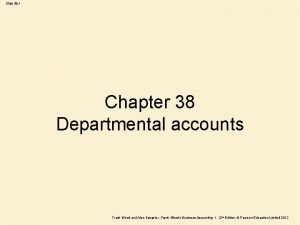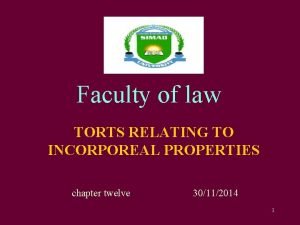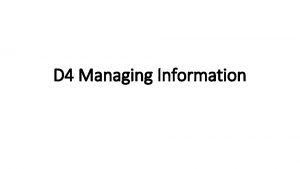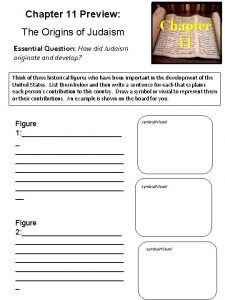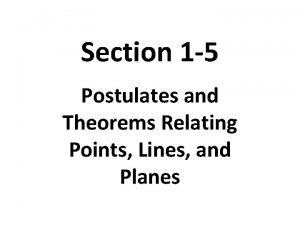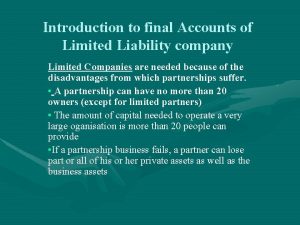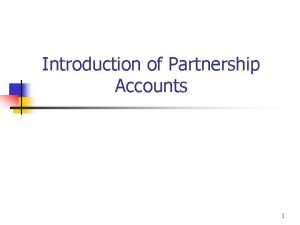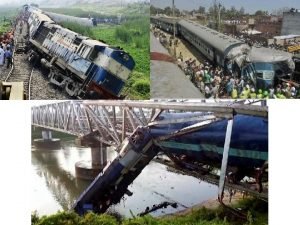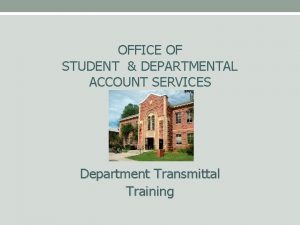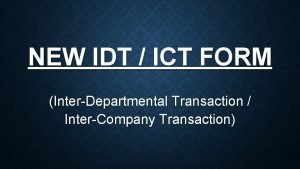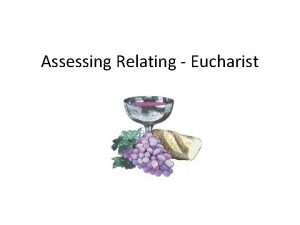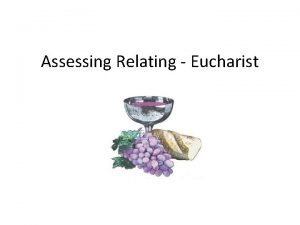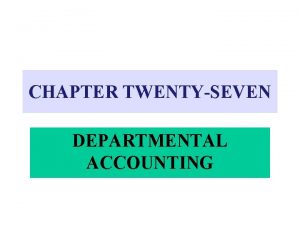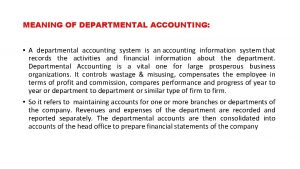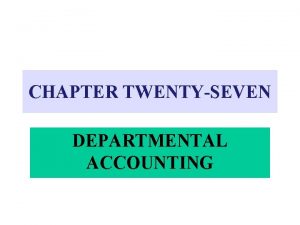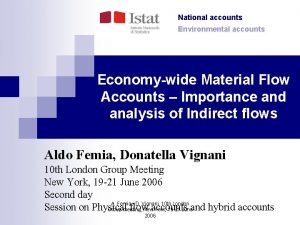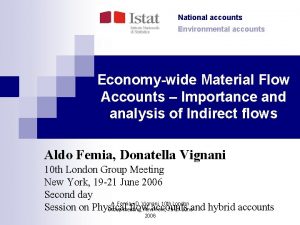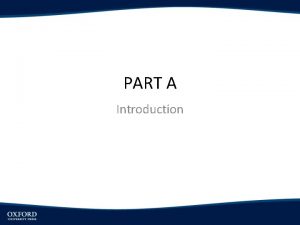DEPARTMENTAL ACCOUNTS Introduction Departmental accounts are accounts relating


























- Slides: 26

DEPARTMENTAL ACCOUNTS

Introduction • Departmental accounts are accounts relating to different department of a business and are used to ascertain the trading results of each department separately. • Such accounts disclose not only the profits of each of the department but also the profits of the whole business.

OBJECTIVES OF DEPARTMENTAL ACCOUNTS • The main objectives of departmental accounts are: • (1) To know the trading result of the various departments. • (2) To compare the trading result of one department with those of other departments. • (3) T o reward the departmental managers on the basis of the trading results. • (4) To help the management to formulate the business policies for the various departments. • (5) To help the business in formulating proper policies relating to the expansion of the business.

Advantages of Department Accounts • • • The main advantages of Departmental accounting are as follows: (1) It provides an idea about the affairs of each department. (2) It helps to evaluate the performance of each department. (3) It helps to reward the Departmental mangers and staff on the basis of performance. (4) It facilitates control over the working of each department. (5) It helps to compare the result of one department with those of other departments. (6) It helps the management to formulate the right business policies for the various departments. (7) It will help in the preparation of departmental budgets. (8) It helps to calculate stock turnover ratio of each department.

Accounting Procedure • A departmental organization can record its transactions in two ways: • (1) Unitary method • (2) Tabular or columnar method

(1) Unitary method • Under this method, the accounts of each department are kept separately. • The results of the various departments are finally combined together in one general P & L account.

(2) Tabular or columnar method • Under this method, the accounts of each department are kept in columnar form with a separate column for each department and also with a separate column for the total. • The tabular method is more popular and is adopted by almost all the departmental undertaking. • Under this method, at the end of the accounting year, Trading and P & L account (columnar) is prepared with separate amount column for each of the department and also for the total. • The trading and P & L of a departmental organization kept in the columnar basis is called Departmental Trading and P & L account. • In trading account, opening stock, purchases, direct expenses and Gross profit are debited and sales and closing stock credited. • Indirect expenses have to be apportioned between the departments and debited to the P&L account.

Allocation of expense • Expenses incurred for a particular department should be directly charged to that department. • But common expenses should be apportioned to the different department on suitable basis. • Following basis for apportionment may be adopted

Basis for Allocation of Common Expenses • • • (1) Expenses on purchase: - Such as freight, carriage in wards, discount received, import duty, octopi etc should be apportioned in the ratio of net purchases ( excluding inter departmental purchases) of each department. (2) Expenses on sales: - Such as selling commission, bad debts, discount allowed, reserve for bad debts , reserve for discount on debtors, sales tax, carriage outwards, advertisement etc, subject should be apportioned in the ratio of net sales ( excluding interdepartmental sales) of each department. (3) Expenses on building: - These should be apportioned on the basis of area or floor space occupied by each of the departments. (4) Expenses on machines: - Such as depreciation, repairs etc should be apportioned on the basis of the value of machines used in each department. In the absence of information, these expenses should be apportioned on the basis space occupied by machines in each department. (5) Lighting and heating- These expenses should be apportioned on the basis of meter readings of the various departments. In the absence of meter readings, they should be apportioned on the basis of light points of each department. In the absence of light points, these expenses should be apportioned on the basis of the space occupied by each department. (6) Insurance premium: - It should be apportioned on the basis of the value of the subject matter insured. For example, insurance premium on stocks insured should be apportioned on the basis of stocks held by each department.

• (7) Labour welfare expenses: - Such as recreation expenses, canteen expenses etc should be apportioned on the basis of the number of workers working in each department. • (8) Workmen’s compensation insurance: - This expenses should be apportioned in the ratio of wages of each department. • (9) Other expenses: - Such as interest on capital, interest on debentures, general manger’s salary, audit fee, directors’ fee, bank charges, legal charges, sundry office expenses etc. can be allocated on any appropriate basis, say, on the basis of sales or cost of sales or quantity of goods sold or equally. Alternatively, these expenses need not be allocated. • They can be charged to General Profit and Loss account the following.

Allocation of incomes • Common incomes should be allocated among different departments on the following basis: • (1) Discount received and reserve for discount on creditors: - They should be allocated on the Basis of net purchases of each department. • (2) Commission earned on sales: - It should be allocated on the basis of net sales of each department. • (3) Other incomes: - Such as dividend received, transfer fees etc can be allocated equally. • Alternatively, they can be credited to General P & L account.

Inter-Departmental Transfer • 1. Methods of Transfer Pricing : Transfers made by one department to another may be recorded either at (a) Cost or (b) Market Price or (c) any other appropriate method e. g. Cost + Agreed Profit Mark Up. • 2. Accounting : When transfers are made, their value should be credited as Income of the Transferring Department and debited as cost of the Recipient Department. • When profit is added in the inter-departmental transfers, the loading (unrealised profit) included in the Closing Stock should be reversed, by debiting the General P&L Account and crediting Stock Reserve Account.

Illustrations 1/Text Book Illustration 24 Page 11. 73 • Snow White Ltd has two departments — Cloth and Readymade Clothes. Ready Made Clothes are made by the Firm itself out of cloth supplied by the Cloth Department at its usual selling price. From the following figures, prepare Departmental Trading and Profit and Loss Accounts for the year ended 31 st March : • The Stock in the Readymade Clothes Department may be considered as consisting of 75% Cloth and 25% other expenses. The Cloth Department earned Gross Profit at the rate of 15% during the year. General Expenses of the business as a whole came to Rs. 1, 10, 000.


Note 2: In this case, it is possible to ascertain the Reserve already created against Unrealised Profit in the Opening Stock. In the absence of information, the Reserve should be calculated on the difference in the Opening and Closing Stocks i. e. Rs. 10, 000 in this question. Since the Closing Stock has increased, the Reserve calculated would be debited to P&L A/c. In case of decrease in Stocks, the Reserve would be credited to P&L A/c.

Illustration 2 • The Trading and Profit & Loss Account of Bindas Ltd. for the year ending 31 March is as under Prepare Departmental Accounts for each of the three Departments A, B and C mentioned above after taking into consideration the following : (a) Transistors and Tape Recorders are sold at the Showroom. Servicing and Repairs are carried out at the Workshop. (b) Salaries and wages comprise as follows: Showroom 3/4 th and Workshop 1/4 th It was decided to allocate the Showroom Salaries and Wages in ratio 1: 2 between Departments A and B. (c) Workshop Rent is Rs. 500 per month. Showroom Rent is to be divided equally between Departments A and B. (d) Sundry Expenses are to be allocated on the basis of the turnover of each Department.


• Illustration 3 Samudra & Co, a Partnership Firm has three departments viz. K, L, M which are under the charge of the Partners B, C and D respectively. The following Consolidated P&L Account is given below : From the above Account and the following additional information, prepare the Departmental P&L Accounts for the year ended 31 March 1. Break up of Opening Stock Department wise is: K - Rs. 37, 890; L - Rs. 24, 000 and M -Rs. 20, 000. 2. Total Purchases were as under: K - Rs. 1, 40, 700; L - Rs. 80, 600; M - Rs. 44, 400. 3. Salaries and Wages include Rs. 12, 000 wages of Department M. The balance Salaries should be apportioned to the three departments as 4: 4: 1. 4. Rent is to be apportioned in the ratio of floor space which is as 2: 2: 5. 5. Selling Expenses and Discount Allowed are to be apportioned in the ratio of Turnover. 6. Depreciation on assets should be equally charged to the three departments. 7. Sales made by the three departments were: K - Rs. 1, 80, 000; L - Rs. 1, 30, 000 and M Rs. 90, 000. 8. Break up of Closing Stock Department wise is: K - 45, 100; L - Rs. 22, 300 and M - Rs. 21, 600. The Closing Stock of Department M includes Rs. 5, 700 goods transferred from Department K. However, Opening Stock does not include any goods transferred from other departments. 9. Departments K and L sold goods worth Rs. 10, 700 and Rs. 600 respectively to Department M. 10. Discounts received are traceable to Departments K, L and M as Rs. 400; Rs. 250 and Rs. 150 respectively. 11. Partners are to share the profits as under: (a) 75% of the Profits of Departments K, L and M to the respective Partner in Charge, (b) Balance Profits to be credited as 2: 1: 1. •



Illustration 4 • • • Anand Ltd, has 3 departments X, Y and Z The following information is provided: Particulars X Y Z Opening Stock 3, 000 4, 000 6, 000 Consumption of direct materials 8, 000 12, 000 — Wages 5, 000 10, 000 — Closing Stock 4, 000 14, 000 8, 000 Sales — — 34, 000 Stocks of each Department are valued at cost to the Department concerned. Stocks of X are transferred to Y at a margin of 50% above Department cost. Stocks of Y are transferred to Z at a margin of 10% above departmental cost. Other expenses were : – Salaries 2, 000 – Printing and Stationery 1, 000 – Rent 6, 000 – Interest paid 4, 000 – Depreciation 3, 000 Allocate expenses in the ratio of Departmental Gross Profits. Opening figures of reserves for unrealised profits on departmental stocks were: Department Y-Rs. 1, 000; Department Z-Rs. 2, 000. Prepare Departmental Trading and Profit and Loss Account for the year.



Illustration 5 • Pooma Ltd. has 2 departments M & S. From the following particulars, prepare Departmental Trading Account & Consolidated Trading Account for the year ending 31 March. • Purchased Goods have been transferred at their respective departmental Purchase Cost & Finished Goods at Departmental Market Price. 20% of Finished Stock Closing) at each Department represented Finished Goods received from the other Department.


 Insidan region jh
Insidan region jh How to calculate sales ratio in departmental accounts
How to calculate sales ratio in departmental accounts Departmental accounts format
Departmental accounts format Songs that relate to the great gatsby chapter 7
Songs that relate to the great gatsby chapter 7 Relating decimals to fractions
Relating decimals to fractions Grass floret
Grass floret Factor isolating questions about education
Factor isolating questions about education Example of incorporeal property
Example of incorporeal property Managing information between professionals
Managing information between professionals Sketch a key artifact relating to abraham
Sketch a key artifact relating to abraham Sentences with linking verbs
Sentences with linking verbs Postulate 1-5
Postulate 1-5 Terminology relating to restrictive practice
Terminology relating to restrictive practice This is the mathematical relation relating the three sides
This is the mathematical relation relating the three sides Relating graphs to events
Relating graphs to events Introduction of company accounts
Introduction of company accounts Introduction to final accounts
Introduction to final accounts Introduction to final accounts
Introduction to final accounts Final accounts introduction
Final accounts introduction Introduction to partnership accounts
Introduction to partnership accounts Company accounts introduction
Company accounts introduction Departmental inquiry report format
Departmental inquiry report format Departmental inquiry report format
Departmental inquiry report format Sample of human resource development plan for teachers
Sample of human resource development plan for teachers Daily order sheet in departmental enquiry
Daily order sheet in departmental enquiry Nau student and departmental account services
Nau student and departmental account services Interdepartmental transaction
Interdepartmental transaction


